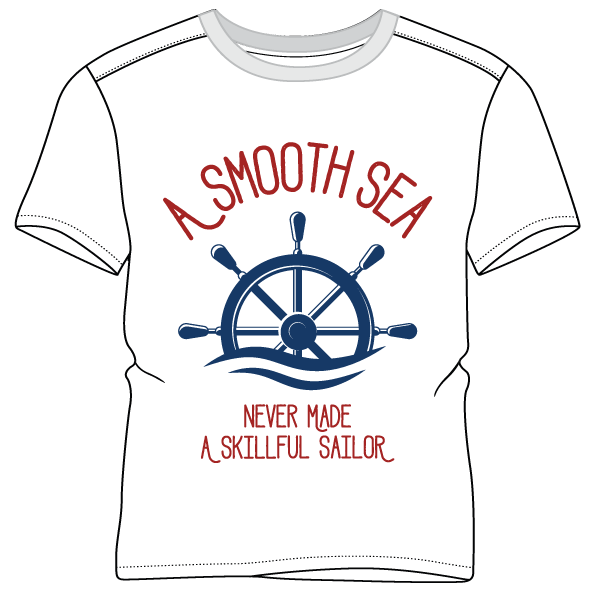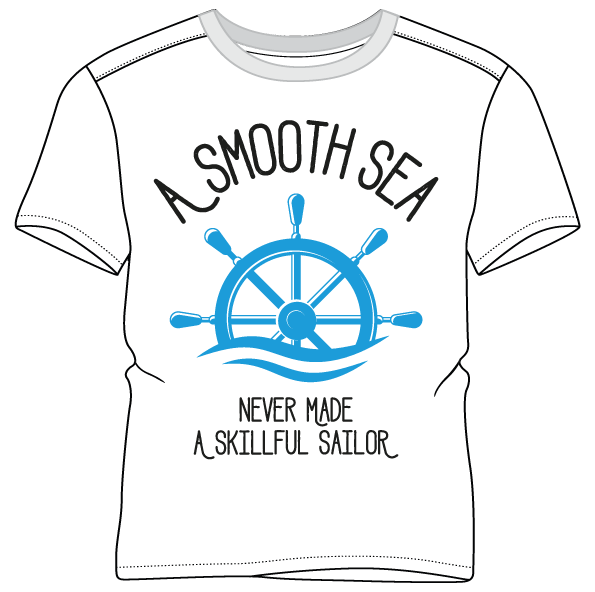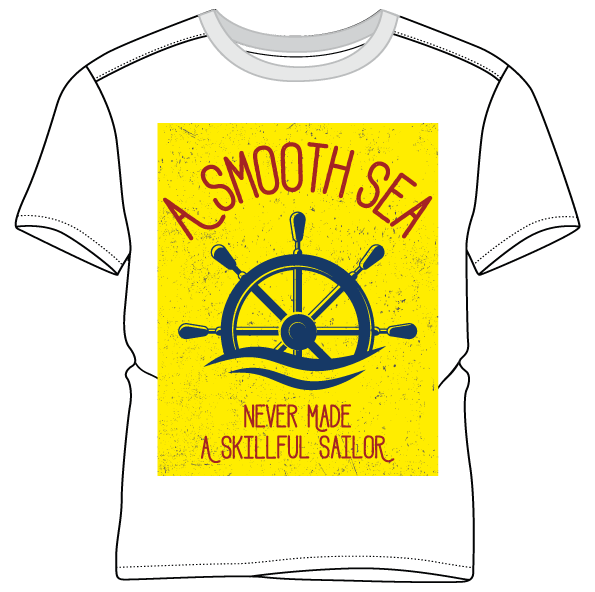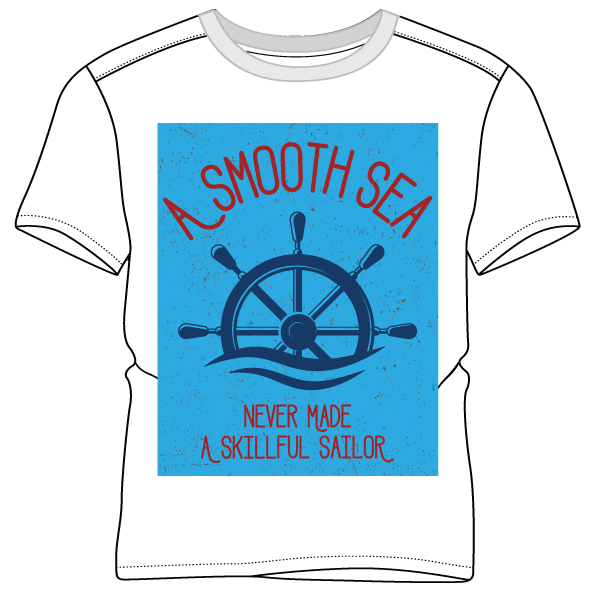Table of contents
Have you ever looked at a t shirt and thought, “That design says everything about me”? That’s the magic of great t shirt graphic design — it turns simple fabric into a statement of style, identity, and creativity. Whether you’re a designer dreaming of launching your own clothing line or a brand owner aiming to make your merch stand out, understanding how to design impactful graphics is the key to success in today’s visual marketplace.
In this guide, we’ll explore what makes t shirt graphics not only look good but sell well. You’ll discover how to move from rough ideas to polished designs, which tools can bring your vision to life, and how current trends are reshaping what’s possible in apparel design.
From mastering composition and color to staying ahead of the curve with new technologies, this is your all-in-one resource to elevate your creative process and produce designs that connect with real people.
So, grab your sketchpad—or open your favorite design app—and let’s dive into the art and strategy behind unforgettable t shirt graphic design.
Understanding T Shirt Graphic Design
What makes a t shirt graphic design stand out from the rest? Is it the color palette, the typography, or the story it tells? The truth is — it’s a combination of all these elements working in harmony. Great design doesn’t just decorate a shirt; it communicates personality, emotion, and identity.
What Is T Shirt Graphic Design?
At its core, t shirt graphic design is the art of turning ideas into wearable visuals. It’s where creativity meets function — blending art, branding, and storytelling. Whether you’re designing for a clothing line, a band, or a small business, your goal is to create something that people actually want to wear.
Why Good Design Matters
In a market flooded with options, strong design is your competitive edge. A well-crafted graphic can:
- Capture attention within seconds
- Communicate your brand’s message instantly
- Turn casual viewers into loyal customers
Think about it — people don’t just buy shirts; they buy the message, the vibe, and the feeling they get wearing them.
Popular Types of T Shirt Graphics
To find your creative direction, it helps to understand the most common styles:
- Illustrative Designs – Hand-drawn artwork, bold and expressive.
- Typographic Designs – Clever use of fonts and words to create impact.
- Minimalist Graphics – Simple, clean, and timeless.
- Photo-Based Prints – High-resolution images or collages that tell a story.
Each style has its own audience and emotional appeal. Experiment with different approaches until you discover what fits your brand’s tone and personality.

Common Design Mistakes to Avoid
Even seasoned designers can stumble when it comes to t shirt graphics. Here are a few pitfalls to watch out for:
- Overcrowding your design — simplicity often sells better than complexity.
- Ignoring print limitations — not every color or gradient translates well to fabric.
- Poor font choices — readability is everything, especially from a distance.
- Lack of contrast — ensure your design pops on different shirt colors.
By staying mindful of these, you’ll save time, money, and ensure your designs look as good in print as they do on screen.
Understanding these fundamentals sets the stage for every creative decision you make next — from sketching your first concept to finalizing production. As we move forward, you’ll learn how to transform inspiration into a professional t shirt graphic design that captures attention and drives real connection.
Creative Process: Turning Ideas Into Wearable Art
Every memorable t shirt graphic design starts with a spark — an idea that grows into something people can connect with. But how do you turn that spark into a design worth wearing? Let’s walk through the creative process that bridges imagination with execution.
Finding Inspiration for T Shirt Designs
Inspiration can come from anywhere — street art, nature, typography, pop culture, or even a personal story. The secret lies in observation and curiosity. Ask yourself:
- What emotions do I want this design to evoke?
- Who will wear this shirt and why?
- How can my design stand out in a crowded market?
Keep a digital or physical inspiration board handy. Collect visuals, colors, quotes, and shapes that resonate with your brand’s identity. Over time, this becomes your creative fuel.
Sketching and Concept Development
Before diving into design software, start with simple sketches. They don’t have to be perfect — they just help visualize your thoughts.
- Brainstorm freely. Sketch multiple versions of the same idea.
- Refine the strongest concepts. Focus on those that tell a clear story.
- Consider composition and placement. Think about how the artwork fits across the shirt — center, pocket area, or wraparound.
This stage is where creativity meets clarity. A strong concept ensures your T shirt graphic design doesn’t just look cool but communicates effectively.
Choosing the Right Colors and Fonts
Color and typography are the silent storytellers of your design. A few guidelines:
- Limit your palette. Too many colors can distract from the message.
- Use contrast wisely. Make sure your design stands out on light and dark fabrics.
- Pick fonts with personality. Fonts should match your message — playful, bold, elegant, or grunge.
Remember, color psychology plays a huge role. Red grabs attention, blue builds trust, and black exudes sophistication.
Designing for Your Target Audience
Design without purpose is decoration. Always design with someone in mind. Whether it’s college students, fitness enthusiasts, or small business owners, understanding your audience shapes your creative direction.
Ask yourself:
- What trends appeal to my audience right now?
- Do they prefer minimal or expressive styles?
- How can I design something they’ll feel proud to wear?
When your audience feels seen and understood, your t shirt graphic design becomes more than apparel — it becomes self-expression.
The creative process isn’t about perfection; it’s about progression. Every sketch, color choice, and font selection brings your vision closer to reality. In the next section, we’ll explore the essential tools that transform these ideas into professional-grade designs ready for print.

Essential Tools for T Shirt Graphic Design
So, you’ve got your concept — now it’s time to bring it to life. The right t shirt graphic design tools can make all the difference between a rough idea and a polished masterpiece. But with so many design programs and resources out there, where should you start? Let’s break down the essentials every designer should know.
Top Software for Beginners and Pros
Whether you’re just starting out or you’ve been designing for years, the right software gives you the control and flexibility to create professional-quality graphics. Here are a few standouts:
- Adobe Illustrator – Perfect for vector-based designs that can scale without losing quality.
- Adobe Photoshop – Great for photo manipulation and textured effects.
- Canva – A beginner-friendly option with templates that speed up the creative process.
- Procreate – A go-to app for hand-drawn designs on iPads.
Each tool has its strengths. Experiment and find the one that fits your workflow and creative goals best.
Online Resources and Design Marketplaces
You don’t have to design from scratch every time. Online platforms offer templates, mockups, and graphic assets that can enhance your work:
- Creative Market and Envato Elements for high-quality vector packs.
- Freepik and Vecteezy for free and premium design elements.
- Placeit for realistic t shirt mockups to showcase your designs.
These resources save time while keeping your designs fresh and professional — just make sure to personalize them to maintain originality.
Hardware That Enhances Workflow
Designing on the right equipment can dramatically boost your productivity and precision. Consider investing in:
- Drawing tablets like Wacom or XP-Pen for smooth, natural sketching.
- High-resolution monitors for accurate color representation.
- Calibrators to ensure color consistency between screen and print.
Remember, your hardware should empower creativity, not limit it.
Tips for Optimizing Your Design Files
Even the best artwork can lose impact if it’s not properly prepared for print. Follow these quick but crucial tips:
- Save vector files (AI, EPS, or SVG) for scalability.
- Keep resolutions at 300 DPI for crisp, clean prints.
- Convert text to outlines before sending files to printers.
- Use CMYK color mode for print accuracy.
A well-optimized design ensures that what you see on screen matches what appears on the final shirt — every time.
Having the right tools is like having the right brush for a painter — they don’t define your talent, but they elevate your potential. Up next, we’ll dive into design techniques and best practices that turn these tools into works of art that truly stand out in the world of t shirt graphic design.

Design Techniques & Best Practices for T Shirt Graphic Design
Creating a visually stunning t shirt graphic design is more than just about talent — it’s about technique, precision, and understanding how design meets production. You might have the most creative idea in the world, but if it’s not prepared correctly, it won’t print the way you envisioned. Let’s explore the methods and best practices that separate amateur designs from professional-quality results.
Understanding Print Methods
Before finalizing your design, it’s important to know how it will be printed. Each printing method affects color, texture, and durability differently. The main options include:
- Screen Printing – Ideal for bold, simple graphics with solid colors. It’s cost-effective for bulk orders and delivers vibrant, long-lasting results.
- Direct-to-Garment (DTG) – Perfect for complex, full-color designs. It allows for small runs without setup costs.
- Sublimation Printing – Great for all-over prints or polyester materials. It transfers dye directly into the fabric for a smooth, professional finish.
By understanding these methods, you can design with intention — ensuring your work translates beautifully from screen to shirt.
How to Prepare Artwork for Printing
Even the most eye-catching design can fail in production if not properly formatted. To avoid costly mistakes, follow these essential steps:
- Use the right file type. Vectors (AI, EPS, SVG) are best for scalability.
- Maintain high resolution. Stick to 300 DPI for clean, sharp results.
- Set up your color modes correctly. Use CMYK for print, not RGB.
- Include bleed margins. This ensures no white edges appear after trimming.
- Double-check placement and sizing. Visualize how your design will sit on different shirt sizes.
These small details can make a huge difference in final quality and print consistency.
Balancing Creativity with Simplicity
It’s easy to get carried away with complex graphics, gradients, and effects — but simplicity often wins. The most memorable T shirt graphic designs are clean, bold, and easy to recognize from a distance. Ask yourself:
- Does every element in my design serve a purpose?
- Will it still look good when scaled down or printed in one color?
- Can someone instantly understand the message or theme?
Sometimes, less truly is more. A strong concept paired with a minimalist approach often results in a timeless design.
Creating Reusable Design Templates
If you’re designing multiple shirts, creating templates saves time and keeps your work consistent. Consider building:
- Layout templates for logo placement and print zones.
- Color palettes that align with your brand identity.
- Typography sets that maintain a cohesive style across designs.
This systemized approach streamlines your workflow, ensuring that every project reflects the same quality and creative integrity.
When you apply these best practices, you’re not just designing — you’re crafting an experience. Each print becomes a wearable piece of art, perfectly aligned with your creative vision. Up next, we’ll explore the latest t shirt graphic design trends shaping the industry and how you can use them to stay ahead of the curve.

Emerging Trends in T Shirt Graphic Design
Fashion evolves, and so does t shirt graphic design. What was once about simple slogans and bold prints has now transformed into a dynamic mix of digital artistry, personalization, and sustainability. If you want your designs to stay relevant — and profitable — it’s crucial to understand the trends shaping today’s market.
Minimalist and Retro Styles
Less clutter, more character. Minimalist designs continue to dominate because they offer clean lines, subtle messages, and timeless appeal. Think small icons, single-tone graphics, and intentional white space.
On the other end, vintage-inspired and retro aesthetics are making a huge comeback. Nostalgic color palettes, distressed textures, and ‘90s-style typography remind wearers of simpler times. Combining minimalism with a retro twist can make your T shirt graphic design stand out while appealing to both modern and nostalgic audiences.
AI and Automation in T Shirt Design
Artificial intelligence is no longer just a buzzword — it’s a design partner. Tools like Midjourney, DALL·E, and Adobe Firefly are revolutionizing the way artists create. These AI-driven platforms can help generate unique concepts, color palettes, or even full mockups in minutes.
But here’s the key: AI shouldn’t replace your creativity — it should enhance it. Use it for brainstorming or speeding up repetitive tasks, freeing you to focus on storytelling, emotion, and originality in your t shirt graphic design.
Sustainability and Ethical Design Choices
Today’s consumers care about the story behind what they wear. Sustainability is no longer optional — it’s expected. Eco-friendly fabrics, water-based inks, and ethical production practices are becoming the new standard.
As a designer, you can embrace this movement by:
- Choosing printing methods that reduce waste.
- Using organic or recycled materials in production.
- Creating designs that encourage longevity over fast fashion.
Sustainability not only benefits the planet but also strengthens your brand’s reputation and customer trust.
Personalization and Customization Trends
People love wearing something that feels uniquely theirs. From custom monograms to interactive QR codes that lead to digital art, personalization is the next big wave in T shirt graphic design.
Brands are offering tools that let customers tweak designs — change colors, add names, or select favorite icons — before ordering. This level of interaction turns shoppers into co-creators, building stronger emotional connections and boosting repeat sales.
Building a Brand Around Your T Shirt Graphic Design
A great t shirt graphic design can grab attention, but a strong brand keeps people coming back. Your designs may be the heart of your business, but your brand is the soul — it’s what connects your art to your audience on a deeper level. Whether you’re launching your first online store or expanding an existing line, building a brand around your designs is how you turn creativity into a thriving business.
Developing a Cohesive Visual Identity
Consistency builds recognition. Every visual element — from your logo to your color scheme — should align with your design style and message. Ask yourself:
- What emotions do I want my brand to evoke?
- How can I translate my design aesthetic into a recognizable look?
- Do my website, social media, and packaging feel unified?
Create a brand style guide that outlines your fonts, tone, and color palette. This ensures every design and marketing piece tells the same visual story, helping customers instantly recognize your work in a crowded market.
Marketing Your T Shirt Graphics Online
Even the most beautiful designs need visibility. Thankfully, marketing your t shirt graphic design in the digital age has never been more accessible. Consider these strategies:
- Social Media Marketing – Use platforms like Instagram, Pinterest, and TikTok to showcase designs, share behind-the-scenes content, and connect with followers.
- SEO-Optimized Blogging – Create posts that highlight your creative process, design tips, or fashion insights to drive organic traffic.
- Email Newsletters – Keep your audience updated on new drops, discounts, and creative stories.
- Collaborations – Partner with influencers or other brands for cross-promotion and increased reach.
The more consistently you share valuable, engaging content, the more trust and loyalty you’ll build with your audience.
Collaborating with Printers and Manufacturers
A flawless design can lose its magic if the print quality falls short. That’s why partnering with reliable printers and manufacturers is essential. When choosing collaborators, focus on:
- Print accuracy – Ensure your colors and details stay true to your original design.
- Material quality – Choose fabrics that complement your design and last over time.
- Communication – Clear, ongoing collaboration helps avoid production surprises.
Building relationships with trusted partners ensures your designs maintain their intended impact — from the digital canvas to the customer’s wardrobe.
7 Best Custom T Shirt Websites to Bring Your Ideas to Life
Scaling Your T Shirt Design Business
Once your foundation is solid, it’s time to scale. Growth doesn’t have to mean losing authenticity — it means reaching more people who love what you create. Some smart ways to expand include:
- Offering limited-edition collections or seasonal drops.
- Launching complementary products like hoodies or tote bags.
- Outsourcing tasks such as fulfillment, social media, or design assistance.
Scaling strategically lets you focus on what you do best — creating stunning t shirt graphic designs that inspire and connect.
At the end of the day, great t shirt graphic design is more than pixels on a screen — it’s a form of self-expression that blends art, strategy, and emotion. Whether you’re crafting your first design or refining your 100th collection, every shirt you create tells a story — your story.
Think back to what inspired you to start designing in the first place. Was it the thrill of seeing your ideas come to life, or the satisfaction of watching someone proudly wear your art? That’s the essence of impactful design — connecting creativity with purpose.
As you move forward, remember these key takeaways:
- Stay curious. Trends evolve, and so should your creativity.
- Prioritize quality. A well-made design and product speak louder than any marketing campaign.
- Design with intent. Every graphic should evoke emotion, tell a story, or make a statement.
Your next design could be the one that sparks a movement, defines a style, or builds a brand that stands the test of time. So keep experimenting, keep refining, and most importantly — keep creating.
The world doesn’t just need another t shirt; it needs your unique design — the one that makes people stop, smile, and say, “I want to wear that.”
Here is an open source t-shirt design you can download.